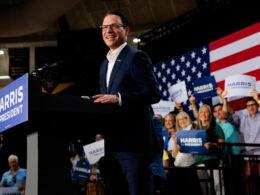Baby boomers are more likely than millennials to have less than $1,000 in savings as the cost-of-living-crisis hits the older generation too, new figures show.
Australian consumers in their 60s and 70s are often accusing of prolonging the inflation crisis, based on the theory those who own their own home without a mortgage have more money to splurge.
But boomers, who are more likely to qualify for the age pension at 67, are also more likely to be retired and therefore not have the cashflow from wages to pay for life’s unexpected expenses, including medical bills.
When it came to having less than $1,000 in the bank or stashed away, 15.1 per cent of those born between 1946 and 1964 were in this dire situation, new data from financial comparison group InfoChoice has revealed.
By comparison, 14.7 per cent of millennials born between 1981 and 1996 were strapped for savings.
Generation Z adults, born since 1997, are less likely to be paying off a mortgage but they are the ones with the least savings because they are more likely to be renting or paying off a university study debt.
One in five or 19.1 per cent of them had less than $1,000 in the bank, with this group revealing they were more likely to spend money on tattoos, lip fillers and Botox – despite being too young for wrinkles.
That was only marginally ahead of the 17 per cent figure for Generation X Aussies, born between 1965 and 1980, with this group more likely to be paying off a mortgage and raising teenage children.

Baby boomers are more likely than millennials to have less than $1,000 in savings as the cost-of-living-crisis hits the older generation too, new figures show
The idea that boomers are driving Australia’s inflation crisis, however, has some merit with the survey also showing one in three of them – or 29.2 per cent – had more than $100,000 in savings to be able to live it up with restaurant meals, new cars and cruises.
InfoChoice money analyst Harrison Astbury said boomers were surprisingly less conservative with money, with many also the victims of failing to plan financially.
‘The youngest generation can be quite conservative in their approach to saving and wealth building,’ he said.
‘In contrast are the baby boomers – almost a third of them have savings exceeding $100,000, however a significant portion – more than the average – do not budget at all.’
By comparison, just 16.8 per cent of millennials had more than $100,000 saved up.
Just 6.9 per cent of Generation Z were in this fortunate situation compared with 19.3 per cent for Generation X.
Regardless of age, Mr Astbury said Australians were turning to alcohol and drugs to cope with difficult economic circumstances.
‘Higher-income individuals are more likely to indulge in drugs and adult entertainment, while lower-income respondents tend to spend more on smoking and drinking, suggesting a disproportionate amount of low income earners are hit by government ‘sin’ taxes,’ he said.
‘It’s been a challenging period for managing the cost of living, saving money, and still carving out some space for life’s pleasures – no matter what generation, or whether you’re a mortgage holder or renter.’

Generation Z adults, born since 1997, are less likely to be paying off a mortgage but they are the ones with the least savings because they are more likely to be renting or paying off a university study debt (pictured are youths in Brisbane)
A majority of respondents admitted to drinking and indulging in fatty food.
‘When it comes to discretionary spending – life’s guilty pleasures – more than half of the respondents admit to spending on vices such as alcohol, fast food, and gambling,’ Mr Astbury said. ‘I call the other 45-odd-per-cent liars.’
More than 40 per cent of Australians weren’t investing money in growth-orientated assets beyond property and superannuation, in things like shares, bonds, financial derivatives, cryptocurrency or exchange traded funds.
The younger Generation Z crowd was even more risk averse, with half of them choosing to keep their savings beyond property and super in cash.
The InfoChoice survey of 1,000 respondents was taken in June, and canvassed views on how savings were stored, from bank deposits to physical cash.









